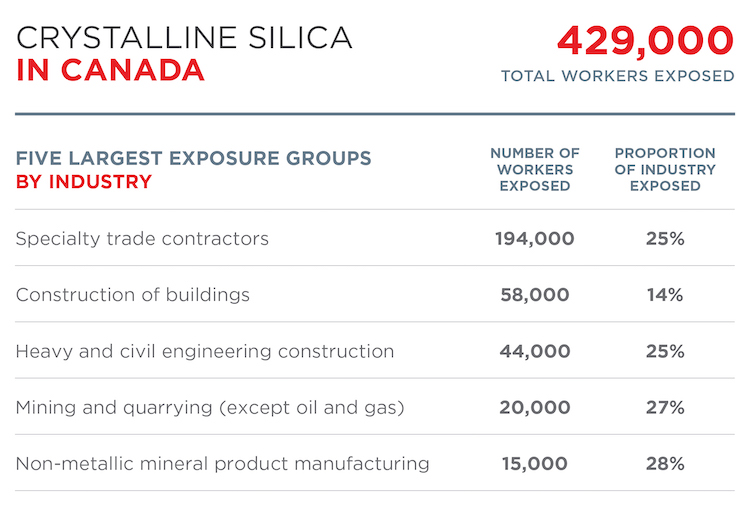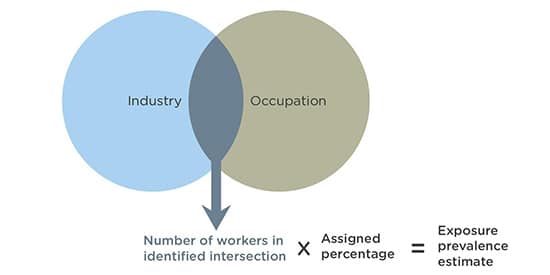Silica (Crystalline) Occupational Exposures
Silica (Crystalline) Occupational Exposures
Overview
Inhalation is the most important route of occupational exposure to silica.[1]
CAREX Canada estimates that approximately 429,000 Canadians are exposed to silica in their workplace.
READ MORE...
The largest industrial group exposed is construction. In terms of occupation, the largest occupational groups exposed to silica are construction trades labourers, heavy equipment operators, plasterers and drywallers, and plumbers.
Exposure to crystalline silica, especially quartz, may also occur in a number of other industries and occupations due to its wide and variable use.[2] Workers can be exposed in industries such as mining, agriculture, and various manufacturing industries.[1,2,3] Job tasks that are typically associated with exposure to silica include grinding, sandblasting, crushing, chipping, mixing, and plowing.
Emerging research shows that engineered stone is a significant source of silica exposure for those who manufacture, process, and install it.[4,5,6,7] Engineered stone is a composite material made of silica-containing crushed stone bound together by an adhesive, typically polymer resin. It is commonly used in kitchen and bathroom countertops. Engineered stone contains much higher levels of silica (approximately 90%) compared to other countertop materials like granite (40%) and marble (5%), and workers may be exposed through processes that release respirable silica dust, such as cutting and grinding countertop slabs.[4,8] In 2024, Australia became the first country in the world to ban the use, supply, and manufacture of all engineered stone due to the rising rates of silicosis and silica-related diseases among workers.[9]
According to the Burden of Occupational Cancer in Canada project, occupational exposure to crystalline silica leads to approximately 570 lung cancers each year in Canada, based on past exposures (1961-2001).[10,11] This amounts to 2.4% of lung cancer cases diagnosed annually. Most occupational lung cancers associated with crystalline silica occur among workers in the construction sector. Work-related silica exposure resulted in approximately $562 million in costs for newly diagnosed lung cancer cases in 2011.[11]
Prevalence Estimate
Results indicate that approximately 429,000 Canadians are occupationally exposed to silica; 94% of these workers are male. The largest industry exposed is construction, where the speciality trade contractors, building construction industry, and heavy and civil engineering construction industry account for approximately 69% of exposed workers.
When exposure is examined by occupation, the largest exposed groups are construction trades labourers (133,000 workers exposed), heavy equipment operators (46,000 workers exposed), plasterers and drywallers (30,000 workers exposed), and plumbers (24,000 workers exposed).
The number of workers exposed to crystalline silica increased by approximately 47,000 workers from 2006 to 2016 (a 12% increase). This was primarily driven by an increase in the total number of workers in the construction industry.
Workers exposed to silica by industry in 2016

Workers exposed to silica by region in 2016
Click the second tab to view total number of workers exposed.
* = < 50 workers
Level of Exposure
In total, approximately 429,000 Canadians are exposed to silica in their workplaces. The majority of workers exposed to silica are in the high exposure category. A significant number of silica-exposed workers are also at risk of low and moderate exposure.
Workers exposed to silica by exposure level in 2016
Level of exposure by industry
Identifying industries with either 1) workers exposed to high levels of silica or 2) a larger number of workers exposed to silica is important in guiding cancer prevention efforts to prioritize exposed groups and target resources most effectively.
The table below shows the number of workers exposed by industry group and level of exposure to silica. These results highlight industries with the most number of workers, as well as industries with the highest levels of exposure. For example, in the construction industries (236, 237, 238) have the largest number of workers exposed and the majority of exposed workers are in the high exposure category. In other industries, such as Truck Transportation, where exposure sources are more dispersed and ventilation may be better, workers fall into the low exposure category. Depending on the goals of a prevention campaign, exposure reduction in the large industrial group might be a useful strategy, or reducing exposure to those at highest risk of exposure could be seen as a priority. For silica, these two strategies both highlight the construction industry as a priority for reducing exposures.
Workers exposed to silica by exposure level and industry in 2016
*Numbers may not add up due to rounding
Methods and Data
Our Occupational Approach page outlines the general approach used to calculate prevalence and exposure level estimates for workplace exposures.
Data Sources
Data used in developing the occupational estimates for crystalline silica were collected from several sources:
- The Canadian Workplace Exposure Database (CWED) contains approximately 7,600 measurements for crystalline silica exposure. These measurements were collected during the years 1981 to 2004 in Ontario and British Columbia workplaces.
- Noticing a lack of exposure measurements from the construction industry, data from this particular industry was added from Manitoba and Saskatchewan exposure databases, as well as some monitoring data from Alberta, in 2018. An additional 2,400 samples in construction were used for this update.
- Canadian and US scientific peer reviewed publications that addressed crystalline silica exposure in Canada and the United States.
- Grey literature including technical reports from governments and international bodies.
Prevalence Estimate Method
CAREX defines exposure to crystalline silica as inhalation at work to levels significantly exceeding non-occupational background levels.
To determine the number of workers potentially exposed to crystalline silica at work, CAREX occupational exposure experts used methods previously established in other peer-reviewed CAREX projects in Europe. A series of steps were taken to assign exposure proportions to occupations and industries at risk of exposure to crystalline silica. Please note that the 2018 data update described in the Data Sources section above did not affect the prevalence of exposure, only the exposure levels.

- Occupations and industries at risk of possible exposure to crystalline silica were identified using any combination of data sources described above.
- The total number of workers in each identified occupation and industry intersection was obtained from Statistics Canada 2016 census data.
- A percentage of workers exposed was assigned to that occupation and industry intersection. Percentages were determined by consultation with existing evidence in the data sources, previously established methods from the Europe CAREX estimates and the expert judgement of CAREX occupational hygienists.
- The number of workers in the identified group is multiplied by the assigned percentage to calculate the prevalence estimate of workers exposed to crystalline silica.
Exposure Level Method
CAREX uses available workplace exposure measurements in the CWED to create exposure level categories by industry and occupation. For the 2018 update, we sought out and included 2,400 additional silica measurements in the construction industry, and applied the same categorization process as was used in initial estimates. For silica, these categories are:
Category 1: Low Exposure
A group of workers (people in the same job category and industry) is put in this exposure category for one of two reasons:
- The are no valid measurements, but a hygienist identified this group as typically exposed during literature and other reviews;
- There are valid exposure measurements in the CWED and a hygienist review determined that exposure is plausible; AND EITHER:
- There are less than 10 samples available in the CWED, OR
- There are ≥10 measurements available but they do not meet the criteria for Moderate Exposure.
Category 2: Moderate Exposure
A group of workers is put in this exposure category if:
- There are at least 25 individual samples in the CWED, AND
- 20% or more samples have a value higher than 0.0125 mg/m3 (which is ½ of the current occupational exposure limit for crystalline silica).
OR
- There are at least 10, but less than 25, individual samples in the CWED, AND
- 20% or more samples have a value higher than 0.025 mg/m3 (which is the current occupational exposure limit for silica).
Category 3: High Exposure
A group of workers is put in this exposure category if both these criteria are met:
- There are at least 25 individual samples in the CWED, AND
- 20% or more samples have a value higher than 0.025 mg/m3 (which is the current occupational exposure limit for silica).
Sources
Subscribe to our newsletters
The CAREX Canada team offers two regular newsletters: the biannual e-Bulletin summarizing information on upcoming webinars, new publications, and updates to estimates and tools; and the monthly Carcinogens in the News, a digest of media articles, government reports, and academic literature related to the carcinogens we’ve classified as important for surveillance in Canada. Sign up for one or both of these newsletters below.
CAREX Canada
School of Population and Public Health
University of British Columbia
Vancouver Campus
370A - 2206 East Mall
Vancouver, BC V6T 1Z3
CANADA
As a national organization, our work extends across borders into many Indigenous lands throughout Canada. We gratefully acknowledge that our host institution, the University of British Columbia Point Grey campus, is located on the traditional, ancestral, and unceded territories of the xʷməθkʷəy̓əm (Musqueam) people.



